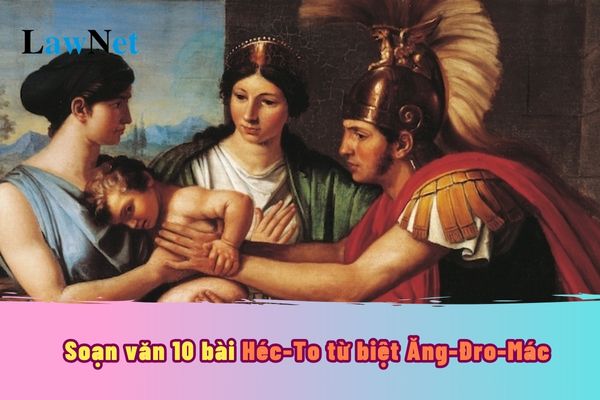Vietnam: What are the guidelines for preparing the lesson "Hector Bids Farewell to Andromache/Héc-to từ biệt Ăng-đrô-mác"? What is the integration of intra-disciplinary (both knowledge and skills) in teaching methods for Literature?
What are the guidelines for preparing the lesson "Hector Bids Farewell to Andromache/Héc-to từ biệt Ăng-đrô-mác"?
10th-grade students shall learn "Hector Bids Farewell to Andromache/Héc-to từ biệt Ăng-đrô-mác" in the Literature curriculum.
The excerpt "Hector Bids Farewell to Andromache/Héc-to từ biệt Ăng-đrô-mác" is an outstanding literary work rich in humanistic values. Through this work, we gain a deeper understanding of the life, emotions, and philosophy of ancient Greeks.
At the same time, the work prompts us to reflect on the eternal values of life.
Students can prepare for the lesson by referring to the sample lesson "Hector Bids Farewell to Andromache/Héc-to từ biệt Ăng-đrô-mác":
|
Guidelines for preparing the lesson "Hector Bids Farewell to Andromache/Héc-to từ biệt Ăng-đrô-mác"
|
*Note: The information is for reference purposes only./.

What are the guidelines for preparing the lesson "Hector Bids Farewell to Andromache/Héc-to từ biệt Ăng-đrô-mác"? What is the integration of intra-disciplinary (both knowledge and skills) in teaching methods for Literature in Vietnam? (Image from the Internet)
Is the cleft rhetorical device taught in the 10th-grade Literature curriculum in Vietnam?
According to Section 5 of the General education program in Literature issued with Circular 32/2018/TT-BGDDT, the Vietnamese language knowledge that 10th-grade students will learn includes:
- Errors in word usage and how to correct them
- Errors in word order and how to correct them
- Cleft rhetorical device, rhetorical devices of enumeration: characteristics and effects
- Errors in paragraph and text linkage: identification signs and correction methods
- Types and genres of texts
+ Argumentative texts: the purpose, viewpoint of the writer; organization and presentation of arguments, reasoning, and evidence; narrative and expressive elements in argumentative texts; essays on social issues; essays analyzing and evaluating a literary work; essays about oneself
+ Informative texts: combining linguistic means and non-verbal communication; combining expressive methods; how to convey information and the writer's viewpoint; comprehensive explanatory texts; rules, and guidelines in public places
- How to mark omitted parts in texts, how to annotate quotes and footnotes
- Non-verbal communication tools: images, data, charts, diagrams, etc.
Thus, the cleft rhetorical device is taught in the 10th-grade Literature curriculum in Vietnam.
What is the integration of intra-disciplinary (both knowledge and skills) in teaching methods for Literature in Vietnam?
According to Section 5 of the General Education Program in Literature issued with Circular 32/2018/TT-BGDDT, the general orientation of teaching methods for Literature is as follows:
The Literature curriculum employs educational methods with a general orientation towards integrative and differentiated teaching; diversifying forms, methods, and teaching tools; and promoting students' active, proactive, and creative learning and application of knowledge and skills.
Based on the program, teachers actively and flexibly build and organize lessons according to the following orientation:
- Implement the integration of intra-disciplinary (both knowledge and skills), interdisciplinary integration, and integration of prioritized educational content (cross-disciplinary); perform differentiated teaching according to student levels across all educational levels and contribute to career orientation in high school.
- Train students in reading, writing, speaking, and listening skills; practice, and experience receiving and applying Vietnamese language and literature knowledge through various forms of in-class and out-of-class activities; focus on using teaching tools, overcome the style of rote teaching, develop thinking, and train students in using media.
- Enhance students' activeness and independence; dedicate more time for students to study textbooks and learning materials, practice, present, discuss, and defend their study results so that they can read, write, speak, and listen according to different requirements and levels; evaluate and assess the completion of students' learning tasks.
Thus, the implementation of the integration of intra-disciplinary (both knowledge and skills), interdisciplinary integration, and integration of prioritized educational content (cross-disciplinary) is specified above.

